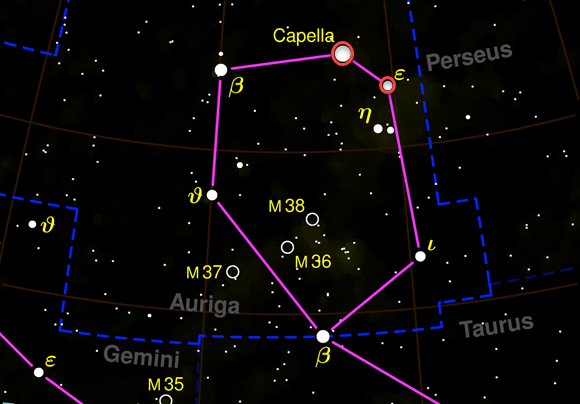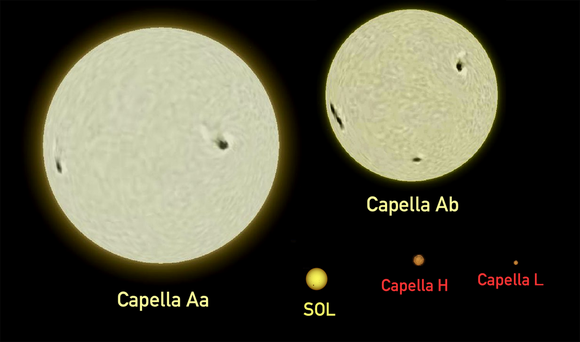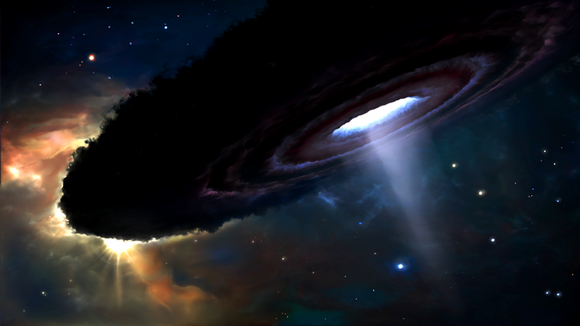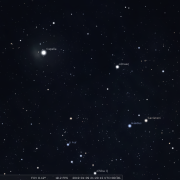Continuing the tour of stellar objects crossing the meridian line this month: Capella from the constellation Auriga - the sixth brightest star in the night sky; and Epsilon Aurigae - an unusual binary system that lies just below it.

Star: Capella (Alpha Aurigae), Chief Star of Auriga the Charioteer
Easily visible unassisted.
Capella (Alpha Aurigae) is the chief star in Auriga the charioteer. It is sometimes known as the goat star, as Auriga is often depicted with a goat on his shoulders and holding two kids. Capella is the sixth brightest star in the sky (apparent mag of 0.08). The only other stars in the northern celestial hemisphere brighter, are Arcturus in Boötes and Vega in Lyra, although Sirius which can be seen from northern latitudes in winter and is the brightest star in the heavens also surpasses Capella. It lies approximately 42.5 light years from earth.
When viewed Capella appears to be a single star, however it is actually a quadruple star system made up of two binary pairs, the stars Capella Aa, Capella Ab are one pair and Capella H, and Capella L, the other. Capella Aa and Capella Ab, are two bright yellow giant stars, both of which are around 2.5 times as massive as the Sun. The second pair, Capella H and Capella L, lie around 10,000 astronomical units from the first pair and are faint, small and relatively cool red dwarfs. (1 AU = 93 million miles =Earth - Sun distance) The system lies approximately 42.5 light years from earth
Capella Aa and Capella Ab are in a very tight circular orbit about 0.74 AU apart taking 104 days to do so. Capella Aa is the cooler and more luminous of the two with a spectral class K0III; it is around 75 times the Sun's luminosity and 12 times its radius. Ab is slightly smaller and hotter and of spectral class G1III; it is around 70 times as luminous as the Sun and 8.5 times its radius.
The Capella system is one of the brightest sources of X-rays in the sky, thought to come primarily from the corona of Capella Aa.
Capella was once the brightest star in the night sky (208,000 BC – 158,000 BC) and was then closer to our solar system, around 30 light years away. It would have had an apparent magnitude of −1.8, brighter than Sirius appears to us today.
You cannot miss Capella in the sky crossing high to the south near the zenith in January.

Comparison of Capella with our Sun ('sol')
Star: Epsilon Aurigae (ε Aurigae) or 'Almaaz'
Easily visible unassisted.
Epsilon Aurigae (ε Aurigae,) or Almaaz lies to the west Capella forming a triangle with eta and zeta aurigae, (Haedus and Saclateni) the ‘kids’. It is an unusual eclipsing binary system comprising an F0 supergiant and a companion which is generally accepted to be a huge dark disk orbiting an unknown object, possibly a binary system of two small B-type stars. The distance is still a little uncertain, but modern estimates place it approximately 1800 light years from Earth.
Epsilon Aurigae was first suspected to be a variable in 1821. About every 27 years, Epsilon Aurigae's brightness drops from an apparent visual magnitude of +2.92 to +3.83. This dimming lasts 640–730 days.
Epsilon Aurigae's eclipsing companion has been subject to much debate since the object does not emit as much light as is expected for an object its size. There are now two main explanations that can account for the known observed characteristics: a high mass model where the primary is a yellow supergiant of around 15 solar masses; and a low mass model where the primary is about 2 solar masses, and a less luminous evolved star.
As of 2008, the most popularly accepted model for this companion object is a binary star system surrounded by a massive, opaque disk of dust. Epsilon Aurigae A an F-type star has around 143 to 358 times the diameter of the Sun, and is around 38,000 times as luminous. The eclipsing component emits a comparatively insignificant amount of light, and is not visible to the naked eye. It is widely thought to be a dusty disc surrounding a class B main sequence star and is approximately 3.8 AU wide, 0.475 AU thick, and blocks about 70% of the light passing through it.
With Auriga located high overhead during the late evenings at this time of year, take a good look (binoculars are ideal) at these stars, which hide a great deal of their magnificence to our ordinary gaze.

Artists Impression of The ε Aurigae system during an eclipse (Brian Thieme)
- Log in to post comments

